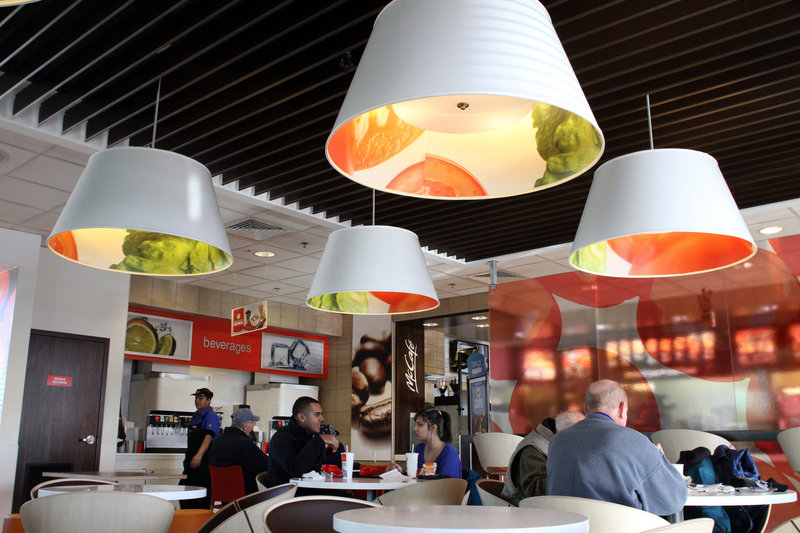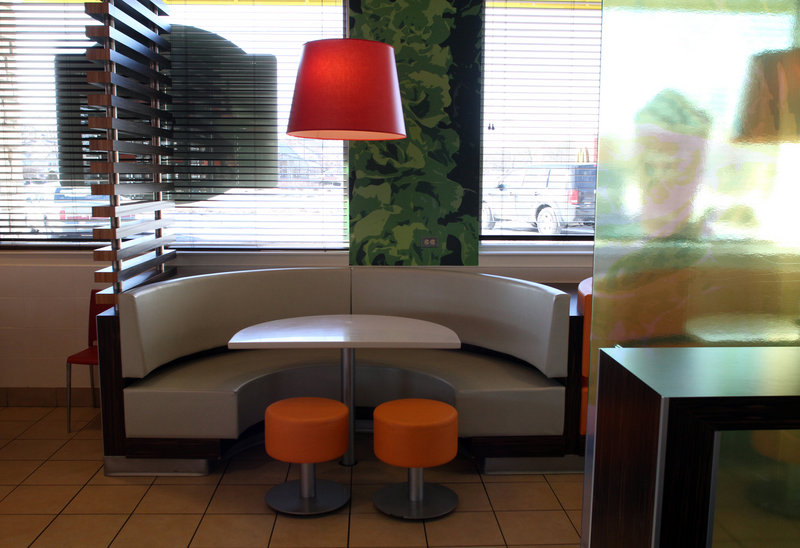CHICAGO – With half-moon shaped booths, low stools, wooden blinds and flat-screen TVs, most patrons might expect to pay $8 for a burger, or $4 for a smoothie. But the decor isn’t a harbinger of price. This is the new look of a remodeled McDonald’s, purveyor of Happy Meals and value deals as well as upscale coffee drinks.
The Oak Brook, Ill.-based burger chain is reaching critical mass on a nearly decade-long, multibillion-dollar global renovation and rebuilding project it’s betting will boost sales, traffic and brand perception. Restaurants undergoing simultaneous interior and exterior remodels are expected to see a 6 percent to 7 percent increase in same-store sales upon reopening, no matter where they are located.
“We are playing a little bit of catch-up,” said Denis Weil, McDonald’s vice president of concept and design, adding that retail remodels now need to happen more frequently. “Styles change faster, and customers have a higher need for novelty, and their tastes change faster as well.”
Once an area has reached 40 percent to 60 percent completion in the remodeling process, Weil said, consumers begin to view the brand differently, stop in more often and buy higher-end items. Analysts say at that point they can also see the lift in sales.
McDonald’s plans to open 1,300 restaurants and remodel 2,400 in 2012, spending about $2.9 billion, the company said last week. The chain pays 40 percent to 45 percent of a franchisee’s remodeling costs for each restaurant, which averages about $600,000 in the U.S. By year-end, the chain will have completed interior renovations on about half of its 33,000 restaurants worldwide.
“We believe now is an opportune time to strategically increase new store openings while continuing a significant focus on reimaging,” McDonalds CFO Pete Bensen said in a call with investors. “We have the financial capacity and talent to invest when many others cannot.”
Although McDonald’s is on a nearly-nine-year streak of global same-store sales gains — most recently reporting a surge of 7.5 percent during the fourth quarter of 2011 — some fast-casual restaurants such as Chipotle and Panera are posting similar or greater same- store sales gains. By adopting a higher-end look, McDonald’s is seeking to gain broader acceptance for top-tier items already on the menu, like smoothies and Angus burgers, and better compete with the fast casual industry.
“The evolution of the McDonald’s brand is, I think, necessary because so many other fast-casual brands are growing up,” said Darren Tristano, executive vice president of Technomic, a Chicago-based food industry consulting firm. He added that McDonald’s has done well to offer more premium products, particularly with drinks such as smoothies and specialty coffees.
In the U.S., bright red, double mansard roofs are being swapped for a single yellow arch outside, and inside two- and four-top tables are being swapped for long, wide, community tables, tall bar tables and more modern booths. About 33 percent of the chain’s 14,098 U.S. units have undergone an interior facelift, and only 16 percent have completed an exterior overhaul.
Weil said that cultural tastes have necessitated different exterior designs by area of the world. But needs inside the restaurants are more common. On the inside, he said, major metropolitan areas like London, New York and Shanghai share a similar look, distinct from suburban or rural areas.
The company is moving to seating “zones,” slow zones for coffee sippers enjoying the Wi-Fi, fast zones at high bar tables for single diners wolfing down a sandwich, and family zones with booths for parents to “lock” their children on the inside to prevent them from wandering.
“We have clear standards around the world,” Weil said. “The design might be different, but we have standards — sleek tables and chairs, contemporary graphics, variable lighting, timeless base materials, seating zones, flexible seating, open floor plans and clean upgraded restrooms — so these are all things you will see in all of the decors.”
McDonald’s has traditionally pushed its franchisees to complete renovations every 20 years. But the new looks are designed with a handful of graphical themes and color palettes that can be swapped out every few years to freshen up the look by updating some lights, wall art and chair coverings, without undergoing another full-scale remodel.
Although franchisees are required to make updates at determined intervals, some are electing to remodel ahead of schedule. Lisa Essig, a McDonald’s owner operator with six restaurants in the Kansas City area, saw an opportunity to increase capacity at one restaurant and get customers’ attention at another.
Her first location saw a double-digit same-store sales lift after the remodel, which expanded the dining area, and increases of more than 7 percent in the second location, where she felt the restaurant had become an expected part of the scenery.
She’s been particularly pleased with the second drive-thru lane, which makes lines look shorter; extra outlets for Wi-Fi seekers, so they’re staying longer (and sometimes ordering more) without jockeying for space; and of course the overall, modernized look.
“Some customers have said even the food looks better,” Essig said, adding that some of the best reactions to the new look have been from seniors, whom she’d feared alienating with a more contemporary design.
Essig said she views her remodels, ranging from $350,000 to $700,000, as long-term investments, and hasn’t calculated how long it will take to break even at each location.
Although France and Australia began redesigning restaurants in the late 1990s, McDonald’s made remodeling part of its global turnaround plan in 2003. The European market increased emphasis on completing them in 2005.The chain once struggled in Europe in part because of poor brand perception, lack of culturally relevant menu items, and other issues. But average restaurant sales have increased in recent years, which the company attributes to remodeling, among other initiatives.
Today, France, Australia and Canada are among some of the most complete areas.
Morningstar analyst R.J. Hottovy said that McDonald’s sales case for the investment has been evident in the chain’s numbers for areas of the world with a significant number of remodels. He added that the remodels are making restaurants “more inviting to customers,” not just because of the upgraded look, but also added features like Wi-Fi and flat screen TVs.
Weil said the updates also help the chain sell more of its higher-end items.
“It’s about permission,” Weil said. “As (President) Don Thompson says, ‘You eat with your eyes first.”‘
Send questions/comments to the editors.




Success. Please wait for the page to reload. If the page does not reload within 5 seconds, please refresh the page.
Enter your email and password to access comments.
Hi, to comment on stories you must . This profile is in addition to your subscription and website login.
Already have a commenting profile? .
Invalid username/password.
Please check your email to confirm and complete your registration.
Only subscribers are eligible to post comments. Please subscribe or login first for digital access. Here’s why.
Use the form below to reset your password. When you've submitted your account email, we will send an email with a reset code.